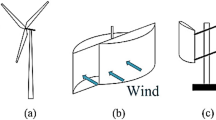Abstract
This paper describes the static simulation of three models of a vertical axis wind turbine car using computational fluid dynamic (Autodesk CFD). In this study, the considered three models have different 3 blade wind turbine: NACA 0012 with an angle of attack 2°, big single C-section and C-section blades. The vertical axis wind turbine car was designed using AutoCAD 2014. The most significant parameter considered in order to design a suitable vertical axis wind turbine car is the aerodynamic drag in terms of drag force and drag coefficient. The simulation was performed for wind speeds ranging between 4 and 8 m/s. The wind speeds have been considered during the analysis under turbulence k–ε model. The results show the aerodynamic drag and the characteristics of streamlines flow that occurs on the vertical axis wind turbine and the body of the car especially for the forebody, upper body, and rear body. These parameters were used to compare the three different models of the wind car. Consequently, it was shown in the results that the big single C-section blade is the most efficient blade for a vertical axis wind turbine car since it has the maximum drag force, compared to the other blades.













Similar content being viewed by others
Notes
Empirical Equation for the flat plate drag coefficient (Abreu 2013).
References
Abreu R, (2013) Adaptive automotive aerodynamics. University of Johannesburg, Johannesburg
Baker C (2010) The flow around high speed trains. J Wind Eng Ind Aerodyn 98(6–7):277–298
Bijlani B, Rathod P, Sorthiya A (2013) Experimental investigation of aerodynamic forces on sedan, fastback and square-back car by simulation in CFD Review Study. Int J Emerg Technol Adv Eng 3(2): 346–349
Bilir L, İmir M, Devrim Y, Albostan A (2015) An investigation on wind energy potential and small scale wind turbine performance at İncek region—Ankara, Turkey. Energy Convers Manag (103):910–923
Çamur H, Kassem Y (2012a) Operating a three blade-wind car with wind energy. Adv Mater Res. https://doi.org/10.4028/www.scientific.net/AMR.622-623.1199
Çamur H, Kassem Y (2012b) Creating the wind energy for operating the 3-C-section blades wind car. Adv Mater Res. https://doi.org/10.4028/www.scientific.net/AMR.622-623.1188
Cheng S, Tsubokura M, Nakashima T, Nouzawa T, Okada Y (2011) A numerical analysis of transient flow past road vehicles subjected to pitching oscillation. J Wind Eng Ind Aerodyn 99(5):511–522
Day AH, Cooper C (2011) An experimental study of interceptors for drag reduction on high-performance sailing yachts. Ocean Eng 38(8–9):983–994
Djavareshkian M, Esmaeli A, Parsani A (2011) Aerodynamics of smart flap underground effect. Aerosp Sci Technol 15(8):642–652
Emilio MD, (2017) Microelectronic circuit design for energy harvesting systems. Springer, Berlin
Emran A, Rob MA, Kabir MH, Islam MN, (2015) Modeling spatio-temporal shoreline and areal dynamics of coastal island using geospatial technique. Model Earth Syst Environ. https://doi.org/10.1007/s40808-015-0060-z
Genta G (2008) Motor vehicle dynamics: modeling and simulation. World Scientific, Singapore
Ghani S, Aroussi A, Rice E (2001) Simulation of road vehicle natural environment in a climatic wind tunnel. Simul Pract Theory 8(6–7):359–375
Heisler H, (2002) Advanced vehicle technology. Elsevier Butterworth Heinemann, Oxford
Heisler H (2004) Advanced vehicle technology. Butterworth Heinemann, Oxford
Jakariya M, Islam MN (2017) Evaluation of climate change induced vulnerability and adaptation strategies at Haor areas in Bangladesh by integrating GIS and DIVA model. Model Earth Syst Environ 3(4):1303–1321. https://doi.org/10.1007/s40808-017-0378-9
Jimmy AN, Khan NA. Hossain MN, Sujauddin M (2017) Evaluation of the environmental impacts of rice paddy production using life cycle assessment: case study in Bangladesh. Model Earth Syst Environ 3(4):1691–1705. https://doi.org/10.1007/s40808-017-0368-y
Kassem Y, Çamur H (2017) A numerical study of a newly developed of savonius wind turbine style on increasing the performance of savonius wind rotor. Am J Mod Energy 3(6):15–120
Kumbernuss J, Chen J, Yang H, Lu L (2012) Investigation into the relationship of the overlap ratio and shift angle of double stage three bladed vertical axis wind turbine (VAWT). J Wind Eng Ind Aerodyn (107):57–75
Ohunakin OS, Oyewola OM, Adaramola MS (2013) Economic analysis of wind energy conversion systems using levelized cost of electricity and present value cost methods in Nigeria. Int J Energy Environ Eng 4(1):2
Onorato M, Costelli A, Garrone A, Viassone L (1986) Experimental analysis of vehicle wakes. J Wind Eng Ind Aerodyn 22(2–3):317–330
Osinowo AA, Okogbue EC, Eresanya EO, Akande OS (2017) Evaluation of wind potential and its trends in the mid-Atlantic. Model Earth Syst Environ 3(4):1199–1213. https://doi.org/10.1007/s40808-017-0399-4
Ozay C, Celiktas MS (2016) Statistical analysis of wind speed using two-parameter Weibull distribution in Alaçatı region. Energy Convers Manag 121:49–54
Puhn F (1986) How to make your car handle. H.P. Books, New York
Raghunathan RS, Kim H, Setoguchi T (2002) Aerodynamics of high-speed railway train. Prog Aerosp Sci 38(6–7):469–514
Rozhdestvensky KV, Ryzhov VA (2003) Aerohydrodynamics of flapping-wing propulsors. Prog Aerosp Sci 39(8):585–633
Sundar S, Mishra AK, Naresh R (2018) Modeling the impact of media awareness programs on mitigation of carbon dioxide emitted from automobiles. Model Earth Syst Environ. https://doi.org/10.1007/s40808-017-0401-1
Viswanath P (2002) Aircraft viscous drag reduction using riblets. Prog Aerosp Sci 38(6–7):571–600
Wang B, Cot L, Adolphe L, Geoffroy S (2017) Estimation of wind energy of a building with canopy roof. Sustain Cities Soc 35:02–416
Watkins S, Vino G (2008) The effect of vehicle spacing on the aerodynamics of a representative car shape. J Wind Eng Ind Aerodyn 96(6–7):1232–1239
Wikipedia (2018) Wind-powered vehicle. https://en.wikipedia.org/wiki/Wind-powered_vehicle. Accessed 7 Feb 2018
Wolf-Heinrich H (1998) Aerodynamic of road vehicle. Society of Automotive Engineers Inc, Pennsylvania
Young DF (2011) A brief introduction to fluid mechanics. Wiley, Hoboken
Acknowledgements
The author wishes to thank the Faculty of Engineering especially the Mechanical Engineering Department for their support during the work validation of this new technology. Also, the author wishes to express their sincere thanks to Assist. Prof. Dr. Hüseyin Çamur for his critical comments.
Author information
Authors and Affiliations
Corresponding author
Rights and permissions
About this article
Cite this article
Kassem, Y. Computational study on vertical axis wind turbine car: static study. Model. Earth Syst. Environ. 4, 1041–1057 (2018). https://doi.org/10.1007/s40808-018-0461-x
Received:
Accepted:
Published:
Issue Date:
DOI: https://doi.org/10.1007/s40808-018-0461-x



